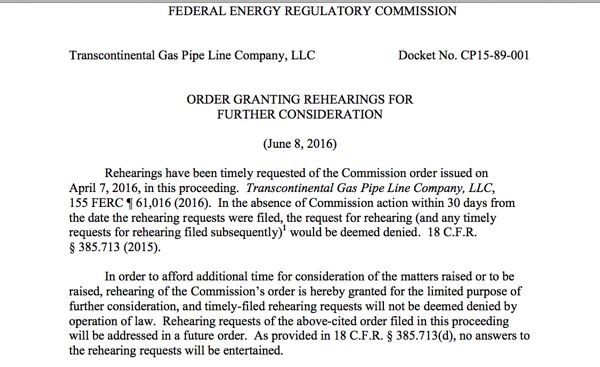Assembly Will Pull The Veto Trigger On June 16
Senate Is Waivering
A digression
Correction: I was wrong when I recently wrote this:
Most of the bad stuff will be adopted in June. Sweeney will have no visible fingerprints on the deal.
In fact, the bad stuff was not adopted in June – it was adopted in May when DEP Commissioner Martin signed the rule (after both Houses of the Democratically Legislature had voted to veto the rule and the Senate Environment Committee Chairman “put a round in the chamber” and urged him not to. Ordinarily, that act of defiance would be a suicidal move – unless Martin knows something we don’t. Now, what might that be?)
It is unclear whether the “no fingerprints” prediction will come about, but it was based on this comment from Senator Sweeney:
404. COMMENT: The proposed Category One designations would appear to be more about curbing development than enhancing water quality standards. Unfortunately, this new regulatory proposal tips the balance even more against the economic prosperity of the areas, district 24 and 3. (127, 221) (source: DEP regulatory document)
But I want to begin this post with a very revealing anecdote, which speaks volumes on the depravity that parades as dignity in Trenton in the toxic Christie era.
Lies are good for business
The lead witness for the business community (Chamber of Commerce, NJ BIA, NAIOP) at yesterday’s Senate Environment Committee hearing on a Resolution (SCR 66) to veto the Christie DEP’s proposed flood hazard rules was lawyer Dennis Toft – previously with the disgraced law firm Wolff & Samson – a man I have described as a “heavy hitter”.
During his introduction, Chairman Smith praised Toft as “the best environmental attorney in the state”.
Take a look at all the damage Toft has done to protections of public health and the environment during the Christie regime:
Toft testified that the C1 steam buffer regulations (SWRPA) the Christie DEP rolled back were a major barrier to redevelopment:
… within 150 feet you could do nothing. … There has been no process to redevelop those sites. Developers are stymied because they can’t go within 150 feet. The rules eliminated the hardship exemptions.
Smith challenged Toft’s claim regarding the lack of a process to be granted a hardship waiver.
DEP agreed with Smith, but was unable to answer Smith’s question about how many hardship waivers were granted.
Later in the hearing, during my testimony, I noted that Toft’s claim that C1 buffer rules served as a barrier to redevelopment was false, because the rules do not apply to previously disturbed land. Redevelopment within the existing disturbed footprint is not restricted by the C1 buffer rules (and there are not many C1 waters in urban areas anyway).
I also noted that Toft’s claim “within 150 feet you could do nothing” directly contradicted DEP Ray Cantor’s testimony that so many waivers were issued that DEP had to make it easier to get them.
After the hearing, in the hall outside the hearing room, I ran into Mr. Toft, who told me that I should continue to mention his name on my blog, because it was good for his business.
Right. You keep on misleading Legislators, Mr. Toft. Great for the professional reputation in Trenton. An apt quote to close:
“‘these men were hollow to the core, reckless without hardihood, greedy without audacity and cruel without courage …’ the only talent that could possibly burgeon in their hollow souls was the gift of fascination which makes a splendid leader of an extreme party.” ~~~ Hannah Arendt in The Origins of Totalitarianism, citing Joseph Conrad’s Heart of Darkness (quoted from Giroux)
Anecdote over – Now to the hearing
The Senate Environment Committee today heard testimony on SCR 66, the Resolution already passed by both Houses of the Legislature to veto the Christie DEP’s proposed rollback Flood Hazard, Stormwater and Coastal zone rules as inconsistent with Legislative intent.
Pursuant to the Constitutional procedure, a second passage by both Houses is required to formally strike down the proposed rule, which was adopted by DEP, after and despite a stern warning by Chairman Bob Smith not to do so:
“It would create a lot of good will with the Legislature to adopt a consolidated rule,’’ Smith told the department, which has been working on the proposal for more than five years. “Save yourselves some heartbreak. Put it in one rule.’’ (NJ Spotlight – 5/17/16)
The Senate Resolution was heard “for discussion only”, so it is unclear whether the Democrats – who control the simple majorities in both Houses needed to veto Governor Christie DEP’s rollback – will have the courage of their convictions and follow through, or whether they will bow to the same powerful development interests that convinced the Christie DEP to roll back some of DEP’s most stringent land use regulations.
Senate Environment Committee Chairman Smith began the hearing by noting that the Assembly will vote to kill the rule on June 16.
So the fate of the proposal is in the Senate, where I’m certain that Mr. Toft and his friends at the Chamber of Commerce, NJBIA, NAIOP, and the Builders Association are putting a full court press on Senate President Sweeney.
That is very troubling, because Senate President Sweeney said THIS about the DEP’s buffer protection program during the Corzine Administration, who was weakening the program at the time but apparently didn’t go far enough for Sweeney:
404. COMMENT: The proposed Category One designations would appear to be more about curbing development than enhancing water quality standards. Unfortunately, this new regulatory proposal tips the balance even more against the economic prosperity of the areas, district 24 and 3. (127, 221) (source: DEP regulatory document)
There was some good testimony by Mike Pisauro and Deb Mans (especially on urban rivers), so folks might want to listen to the marathon 2 hour+ hearing.
I don’t want to go into any detail here about what I said today – I’ve written about most of it many times before, most recently in this post. Interested readers can listen to the hearing here. (but it was a wonderful 25 minute discourse!)
Going deeper into the weeds, here is a followup letter I sent to OLS and Legislators to document my testimony today – the New York State DEC denial of a water quality certificate is key:
Letter to Legislators
Judy – As requested by Chairman Smith, below please find links and excerpts to the documents I referred to in my testimony today on SCR 66.
At the outset, to get a sense of how DEP is spinning the regulatory nuance, I urge you to review DEP’s claims in the response to comments adoption document that the SWRPA was “never a “no build” prohibition and that this was anticipated and resolved by the DEP in the February 2004 response to comments 440-441, 36 N.J.R. 716). See page 118 of the adoption document:
http://www.nj.gov/dep/rules/adoptions/adopt_2016xxxxa.pdf
The cited DEP’s response to comments does NOT say what DEP now claims it did. DEP omitted the fact the the DEP response to comment said that DEP: “anticipates proposal of an amendment to the rules” to provide a hardship waiver. That anticipated rule was never proposed.
You should also read the hardship waiver in the Highlands rules for an example of a rigorous review process and standard. Instead, DEP is making FHA buffer disturbance of C1 SWRPA’s hardship waivers easier to obtain and lowering the standards of approval.
I) Significance of Water Quality Standards
To understand the significance of an affirmative regulatory requirement to demonstrate compliance with State Surface Water Quality Standards, please read the NY State Department of Environmental Conservation (DEC) denial of the Clean Water Ac Section 401 Water Quality Certification for the proposed Constitution Pipeline:
http://www.dec.ny.gov/docs/administration_pdf/constitutionwc42016.pdf
By repealing the SWRPA, the DEP is eliminating the only linkage between stream encroachment permit requirements and Surface Water Quality Standards.
Today, DEP gave conflicting responses to this criticism. Ray Cantor and Ms. Kopkash claimed it was resolved in the adoption document, but contradicted themselves by later by saying it was resolved in the Concurrent proposal.
Both claims are false.
The adoption document does not resolve this problem by cross referencing the Stormwater rules, because the SWRPA C1 provision of the storm water rules has been repealed, thus the stormwater rules are an empty shell with respect to a bridge to C1 Surface Water Quality Standards.
Similarly, in the concurrent proposal the DEP summary falsely claims that the stream encroachment permits are linked to compliance with surface water quality standards, “similar to” the wetlands regulations:
These requirements are similar to the requirements at N.J.A.C. 7:7A-7.2(b) for the issuance of a freshwater wetlands or open water fill individual permit, with amendments to reflect that the proposed subsection is only applicable to riparian zones to a Category One water, making some of the considerations applicable in the freshwater wetlands context not applicable under this subsection, and are intended to ensure that activities within 150 feet of a Category One water or regulated tributary to a Category One water are only conducted when there is no alternative to the activity and that the activity will not lead to the violation of State water quality standards and laws or otherwise have significant adverse environmental consequences.
The wetlands regulation (NJAC 7:7A-7.2(b)) that DEP claims the CP is “similar to” explicitly requires that wetlands permits:
5. Will not cause or contribute to a violation of any applicable State water quality standard;
But the actual text of the CP rule does not include this language from the wetlands rules. While other provisions from the wetlands rules were included in the CP, this critical language was not.
The CP does not require compliance with State water quality standards or include this “cause or contribute to” language from the wetlands rules.
II) Christie Administration Policy Context of proposal
The FHA rule proposal was not a policy neutral attempt to align and streamline allegedly duplicative stream buffer programs (SWRPA and riparian zone). Connect the dots:
1. DEP Transition Report:
The C1 buffer program is targeted and the rollback strategy is openly presented as a recommendation in the DEP Transition Report (see “Omnibus Rulemaking” on page 13)
Reexamine buffer requirements in urban/disturbed areas and Planning Areas 1 and 2 designated for growth under the State Development and Redevelopment Plan (hereinafter referred to as the State Plan) as applied to wetlands, C-1 waters and potential Threatened and Endangered species habitat under Flood Hazard, Stormwater, and Wetlands rules.
2. Governor Christie’s Executive Order #2 regulatory policy objective is to provide “regulatory relief”
http://nj.gov/infobank/circular/eocc2.pdf
3. DEP Commissioner Martin’s “Transformation Plan” is designed to implement Gov. Christie’s EO#2, EO#3 to reduce “job killing Red Tape” and provide “common sense” regulation and Martin’s “customer service” management model.
http://www.state.nj.us/dep/commissioner/2010transformationplan.pdf
4. DEP Report on Category One Program Evaluation –
The Report explicitly links the C1 evaluation recommended in the DEP Transition Report with Martin’s Transformation Plan
“B. Reviewing the Science: C1 Antidegradation Designation Process 1. Stakeholder Discussions
In keeping with the NJDEP’s core transformation principles, this review of the C1 designation process is designed to be inclusive and transparent encouraging input from both internal and external stakeholders. An in-house internal stakeholder discussion was held on September 13, 2010. This was followed by a meeting with external stakeholders on December 10, 2010. (page 7)
http://www.state.nj.us/dep/wms/bears/docs/c1-final-integrated-paper201211.pdf
Finally,, here is the Appellate Division decision relevant to headwater protections being lost by repeal of SWRPA that are not replaced by riparian zone – Without evidence, DEP claims this is “rare” case (see response that begins on page 112):
http://www.nj.gov/dep/rules/adoptions/adopt_2016xxxxa.pdf
IN THE MATTER OF THE NEW JERSEY DEPARTMENT OF ENVIRONMENTAL PROTECTION CATEGORY I WATERSHED DETERMINATION
http://njlaw.rutgers.edu/collections/courts/appellate/a1499-06.opn.html
The SWRPA buffers apply to intermittent streams without defined bed and banks, as the Court found:
“The intermittent stream exists without definable bed and banks but is identifiable as a linear depression, commonly referred to as a “swale.” The Stormwater Management Rules do not require that a perennial or intermittent stream be defined by bed and banks in order to have a SWRPA established. N.J.A.C. 7:8-5.5(h)1.1 states: “A . . . special water resource protection area shall be provided on each side of the waterway, measured perpendicular to the waterway from top of bank outwards or from the centerline of the waterway where the bank is not defined . . . .” (emphases mine)


